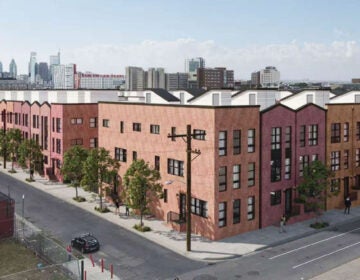Cherelle Parker wants to deliver 30,000 units of housing in Philly. Can it happen?
The mayor has broadened the goal to include new construction and renovations.
Listen 4:43
The Turn the Key program aims to create energy-efficient, affordable housing for city employees or income-eligible first-time homebuyers. The first homes will be built on publicly owned land, like a lot on the 1300 block of Corlies Street in South Philadelphia. (Kimberly Paynter/WHYY)
Have a question about Philly’s neighborhoods or the systems that shape them? PlanPhilly reporters want to hear from you! Ask us a question or send us a story idea you think we should cover.
Mayor Cherelle Parker’s administration is hashing out the details of a plan to deliver 30,000 units of housing over the next four years, an “ambitious” goal rooted in a promise made on the campaign trail.
While she was running in the Democratic primary, Parker pledged to create 30,000 units of affordable housing if elected. The benchmark is now more broadly defined. The administration hopes to build or preserve 30,000 units, whether affordable or market-rate.
“The high-end condo does not help the person that needs affordable housing. We get that. We’re not subsidizing it. We’re not providing land. But they’re doing it and they’re bringing residents to Philadelphia. So it’s important. We need a whole ecosystem of folks in the city for it to be successful,” said John Mondlak, interim director of the city’s Department of Planning and Development during an interview last month.
The plan will count homes and rentals regardless of how they are funded. They can be housing units built by private developers, subsidized units operated by the Philadelphia Housing Authority, homes repaired with the help of state or city funding as well as so-called “naturally occurring” affordable housing.
Beyond that scope, there aren’t many specifics, including how much funding it may take to reach Parker’s target or how many affordable units may be produced or preserved. It will take months of preparation before the effort is in full motion, said Mondlak, who is confident about carrying out his marching orders.
“When you look at it a little more holistically, it’s ambitious, but I don’t know that it’s unachievable,” said Mondlak.
Getting to 30,000
Some housing units are already in the pipeline. And housing experts agree that Parker’s goal is feasible, though advocates hope she doesn’t stray far from her campaign promise as the city continues to experience an affordable housing crisis.
Since 2019, nearly 65,000 units of housing have been built or preserved in Philadelphia, according to an online dashboard maintained by Planning and Development. The total includes affordable and market-rate housing, plus workforce housing and housing for people experiencing homelessness.
The total translates to more than 10,000 units a year.
“Continuing that level of performance is not a stretch,” said John Kromer, Philadelphia’s housing director under Mayor Ed Rendell’s administration.
Vincent Reina, faculty director of the Housing Initiative at the University of Pennsylvania, said the administration may exceed the 30,000 mark during Parker’s first term in office.
“In some ways, it’s kind of a guiding post more than even the end number,” said Reina.
In the private sector, more than 7,000 units are planned for “Greater Center City” alone, according to the Center City District. The area covers a group of growing and well-heeled neighborhoods sandwiched between the Delaware and Schuylkill rivers between Girard Avenue and Tasker Street.
PHA is currently renovating more than 1,0000 scattered site properties. The authority is also getting ready to overhaul Westpark Apartments in West Philadelphia and gearing up to rebuild Bartram’s Village in Southwest Philadelphia.
Those projects represent 1,600 units of housing.
Homes built through the city’s “Turn the Key” program will also go toward Parker’s goal. The initiative is expected to build 1,000 price-restricted homes for first-time homebuyers.

Mondlak’s department will track all of it with a new online portal the public will be able to access.
To help ensure that it meets its goal, the Parker administration wants to expand existing programs, including the Basic Systems Repair Program, which provides free home repairs to income-eligible homeowners. Restore, Repair, Renew, another program Parker wants to grow, offers low-interest loans to residents with low incomes. The goal of both initiatives is to preserve affordable homes and neighborhoods.
Parker has vowed to create “One Front Door” to make it easier for residents to access city-run home improvement programs. The administration is also looking into avenues for improving the city’s regulatory process to help real estate developers get to construction sooner.
“We’re gonna try and figure out what we can do to streamline, to improve. Do we waive fees? Do we put it to the top of the pile? Do we accelerate? Because at the end of the day, especially in a high-interest environment, if you’re talking about private development, carrying costs are significant,” said Mondlak.
He said getting to 30,000 units will require partnerships with community development corporations, nonprofits and philanthropists, which the administration hopes will provide funding to help reach its goal.
However the administration’s plan is funded, housing advocates hope Parker’s goal includes a significant number of deeply affordable units, given that Philadelphia remains the poorest big city in the country. The city’s poverty rate has improved, but federal data shows it’s still high — nearly 23%.
“We want half of the [public] resources to go towards the people who really need it,” said Nora Lichtash, executive director of the Women’s Community Revitalization Project, a member of the Philadelphia Coalition for Affordable Communities.
To Kromer, Parker’s goal doesn’t have much value if it doesn’t help the thousands struggling to make ends meet.
“The real underlying issue that has to be addressed in Philadelphia is poverty. It’s not producing housing,” said Kromer. “Producing a lot more market-rate housing units is not going to do that.”

Subscribe to PlanPhilly
WHYY is your source for fact-based, in-depth journalism and information. As a nonprofit organization, we rely on financial support from readers like you. Please give today.









